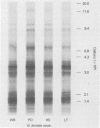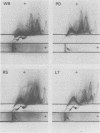Abstract
The trophozoite antigens of Giardia lamblia to which host humoral and cellular immune responses are directed have not been identified. Therefore, we initiated studies to characterize these antigens in strains of G. lamblia from Afghanistan, Oregon, Ecuador, and Puerto Rico. By polyacrylamide gel electrophoresis, the electrophoretic mobility patterns of proteins of the four strains were similar; molecular weights of protein bands ranged between 12,000 and 140,000. The antigens which reacted with rabbit and anti-G. lamblia antisera by immunoelectrophoresis were also similar for the four strains. However, comparison by crossed immunoelectrophoresis showed the Oregon strain, which has been the longest in culture, lacked a set of anodic antigens and the single neutral antigen which were present in the other three strains. In addition, other minor antigen differences between the strains were detected by this technique. When we employed trophozoites from each strain as antigen in an enzyme-linked immunosorbent assay against 10 human antisera of various liters, we also detected some differences between the strains. Although polyacrylamide gel electrophoresis and immunoelectrophoresis revealed gross similarity among G. lamblia from widely differing geographic locations, subtle differences detected by crossed electrophoresis and enzyme-linked immunosorbent assay suggest the existence of potentially important antigenic differences among these strains.
Full text
PDF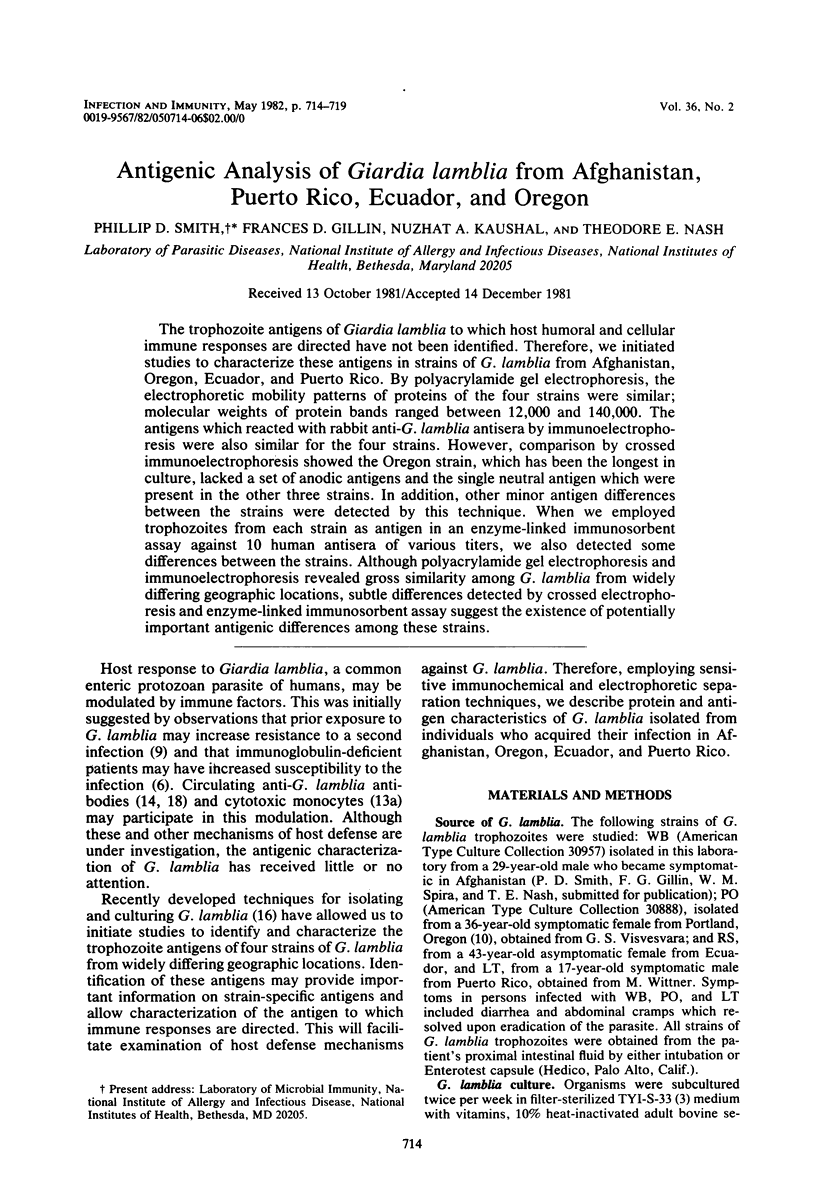
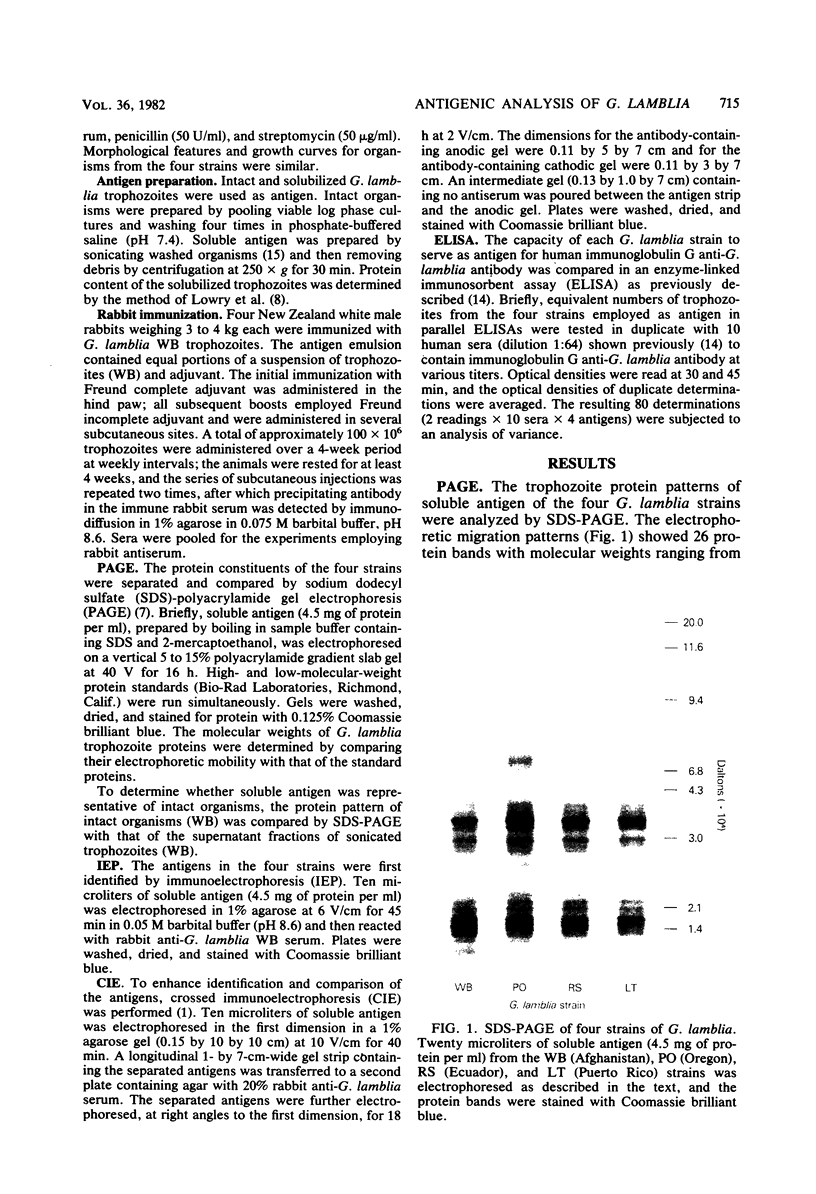

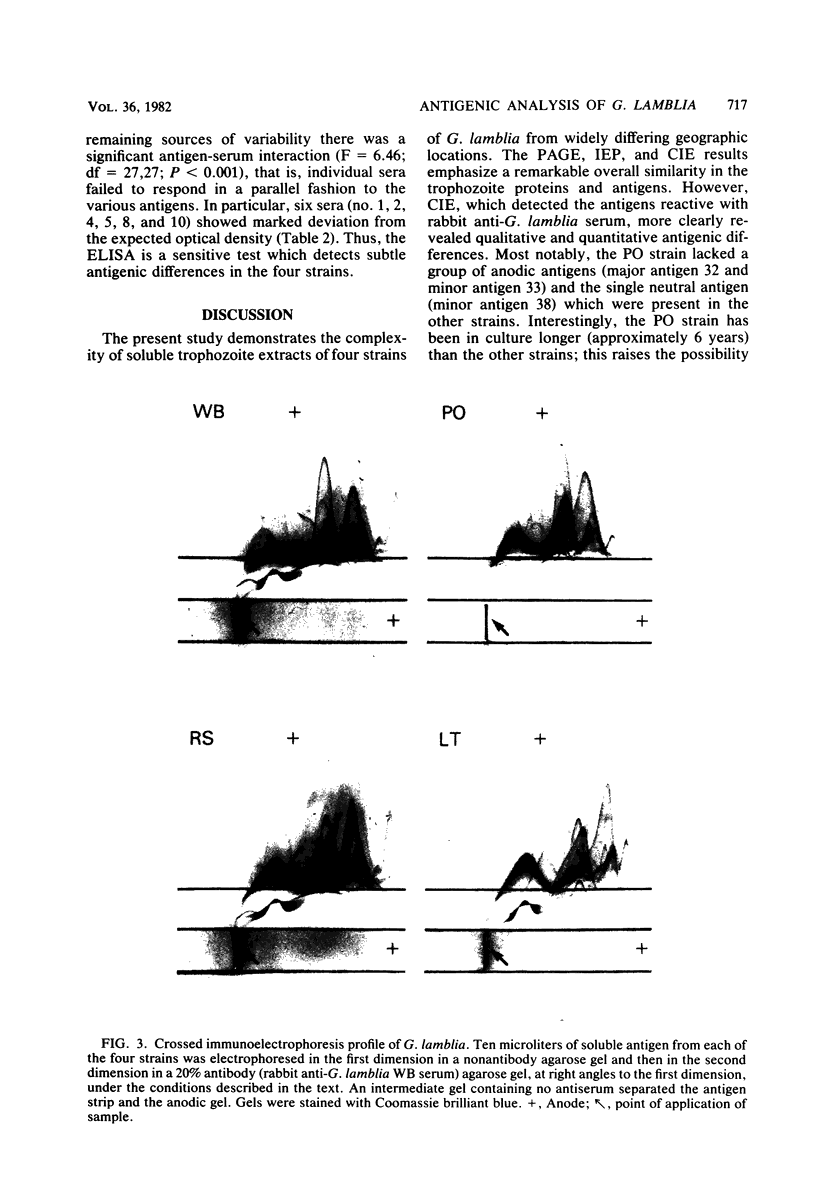
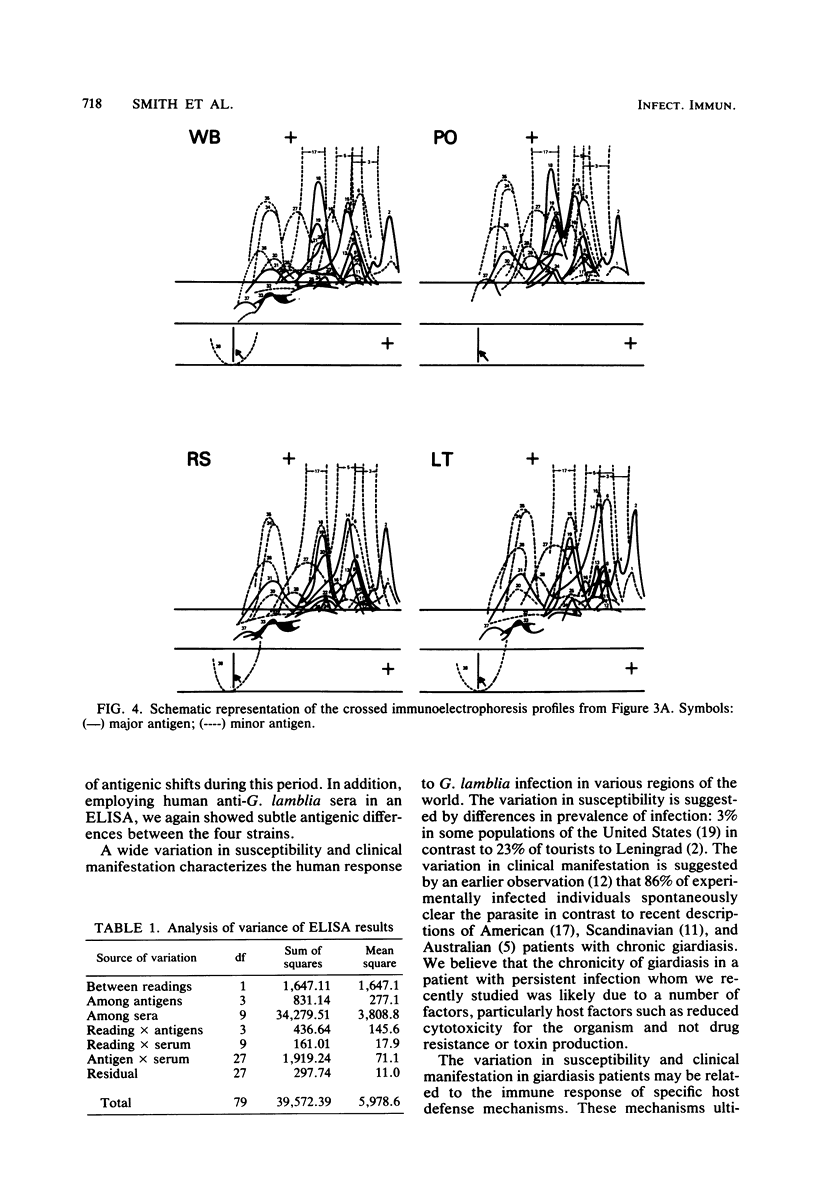
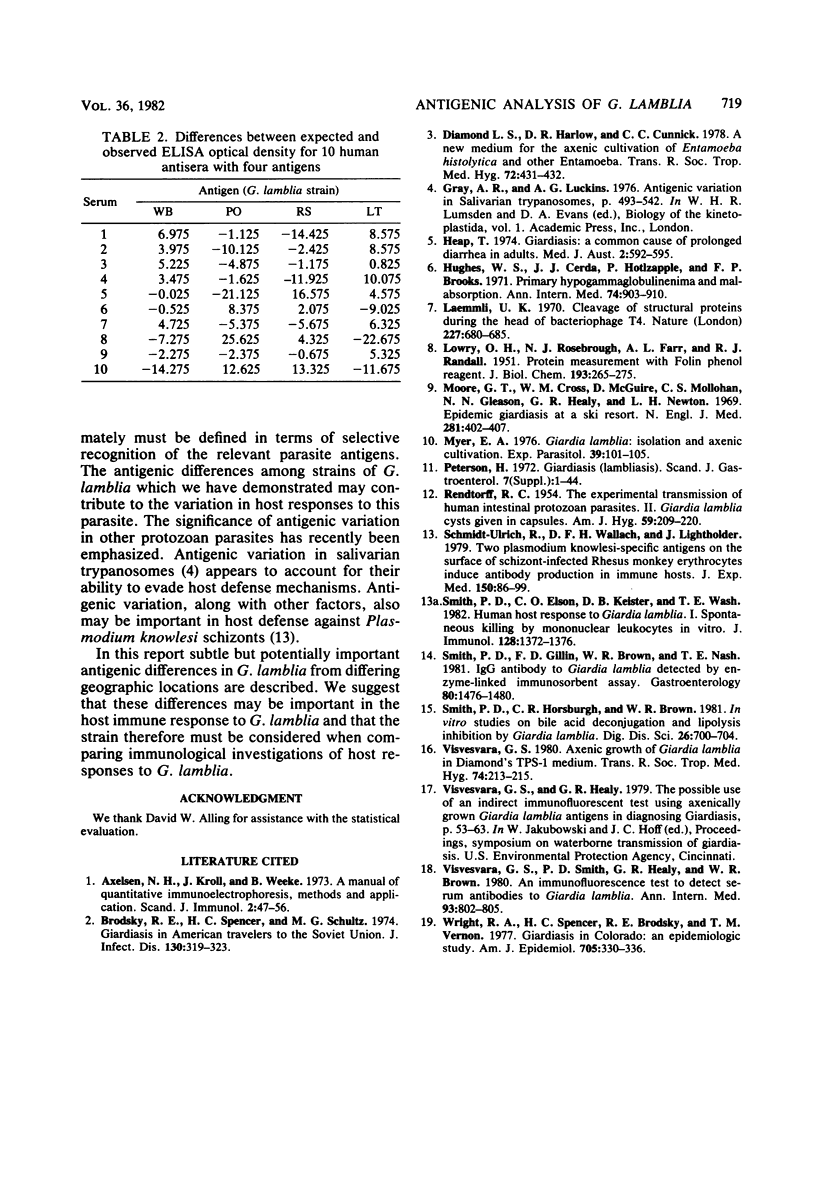
Images in this article
Selected References
These references are in PubMed. This may not be the complete list of references from this article.
- Brodsky R. E., Spencer H. C., Jr, Schultz M. G. Giardiasis in American travelers to the Soviet Union. J Infect Dis. 1974 Sep;130(3):319–323. doi: 10.1093/infdis/130.3.319. [DOI] [PubMed] [Google Scholar]
- Diamond L. S., Harlow D. R., Cunnick C. C. A new medium for the axenic cultivation of Entamoeba histolytica and other Entamoeba. Trans R Soc Trop Med Hyg. 1978;72(4):431–432. doi: 10.1016/0035-9203(78)90144-x. [DOI] [PubMed] [Google Scholar]
- Heap T. Giardiasis: a common cause of prolonged diarrhoea in adults. Med J Aust. 1974 Oct 19;2(16):592–595. doi: 10.5694/j.1326-5377.1974.tb71022.x. [DOI] [PubMed] [Google Scholar]
- Hughes W. S., Cerda J. J., Holtzapple P., Brooks F. P. Primary hypogammaglobulinemia and malabsorption. Ann Intern Med. 1971 Jun;74(6):903–910. doi: 10.7326/0003-4819-74-6-903. [DOI] [PubMed] [Google Scholar]
- LOWRY O. H., ROSEBROUGH N. J., FARR A. L., RANDALL R. J. Protein measurement with the Folin phenol reagent. J Biol Chem. 1951 Nov;193(1):265–275. [PubMed] [Google Scholar]
- Laemmli U. K. Cleavage of structural proteins during the assembly of the head of bacteriophage T4. Nature. 1970 Aug 15;227(5259):680–685. doi: 10.1038/227680a0. [DOI] [PubMed] [Google Scholar]
- Meyer E. A. Giardia lamblia: isolation and axenic cultivation. Exp Parasitol. 1976 Feb;39(1):101–105. doi: 10.1016/0014-4894(76)90016-3. [DOI] [PubMed] [Google Scholar]
- Meyerowitz B. R. Surgical treatment of intractable morbid obesity. Scand J Gastroenterol. 1972;7(1):1–2. doi: 10.3109/00365527209180729. [DOI] [PubMed] [Google Scholar]
- Moore G. T., Cross W. M., McGuire D., Mollohan C. S., Gleason N. N., Healy G. R., Newton L. H. Epidemic giardiasis at a ski resort. N Engl J Med. 1969 Aug 21;281(8):402–407. doi: 10.1056/NEJM196908212810802. [DOI] [PubMed] [Google Scholar]
- RENDTORFF R. C. The experimental transmission of human intestinal protozoan parasites. II. Giardia lamblia cysts given in capsules. Am J Hyg. 1954 Mar;59(2):209–220. doi: 10.1093/oxfordjournals.aje.a119634. [DOI] [PubMed] [Google Scholar]
- Schmidt-Ullrich R., Wallach D. F., Lightholder J. Two Plasmodium knowlesi-specific antigens on the surface of schizont-infected Rhesus monkey erythrocytes induce antibody production in immune hosts. J Exp Med. 1979 Jul 1;150(1):86–99. doi: 10.1084/jem.150.1.86. [DOI] [PMC free article] [PubMed] [Google Scholar]
- Smith P. D., Elson C. O., Keister D. B., Nash T. E. Human host response to Giardia lamblia. I. Spontaneous killing by mononuclear leukocytes in vitro. J Immunol. 1982 Mar;128(3):1372–1376. [PubMed] [Google Scholar]
- Smith P. D., Gillin F. D., Brown W. R., Nash T. E. IgG antibody to Giardia lamblia detected by enzyme-linked immunosorbent assay. Gastroenterology. 1981 Jun;80(6):1476–1480. [PubMed] [Google Scholar]
- Smith P. D., Horsburgh C. R., Jr, Brown W. R. In vitro studies on bile acid deconjugation and lipolysis inhibition by Giardia lamblia. Dig Dis Sci. 1981 Aug;26(8):700–704. doi: 10.1007/BF01316858. [DOI] [PubMed] [Google Scholar]
- Visvesvara G. S., Smith P. D., Healy G. R., Brown W. R. An immunofluorescence test to detect serum antibodies to Giardia lamblia. Ann Intern Med. 1980 Dec;93(6):802–805. doi: 10.7326/0003-4819-93-6-802. [DOI] [PubMed] [Google Scholar]
- Weeke B. Crossed immunoelectrophoresis. Scand J Immunol Suppl. 1973;1:47–56. doi: 10.1111/j.1365-3083.1973.tb03778.x. [DOI] [PubMed] [Google Scholar]
- Wright R. A., Spencer H. C., Brodsky R. E., Vernon T. M. Giardiasis in Colorado: an epidemiologic study. Am J Epidemiol. 1977 Apr;105(4):330–336. doi: 10.1093/oxfordjournals.aje.a112390. [DOI] [PubMed] [Google Scholar]



